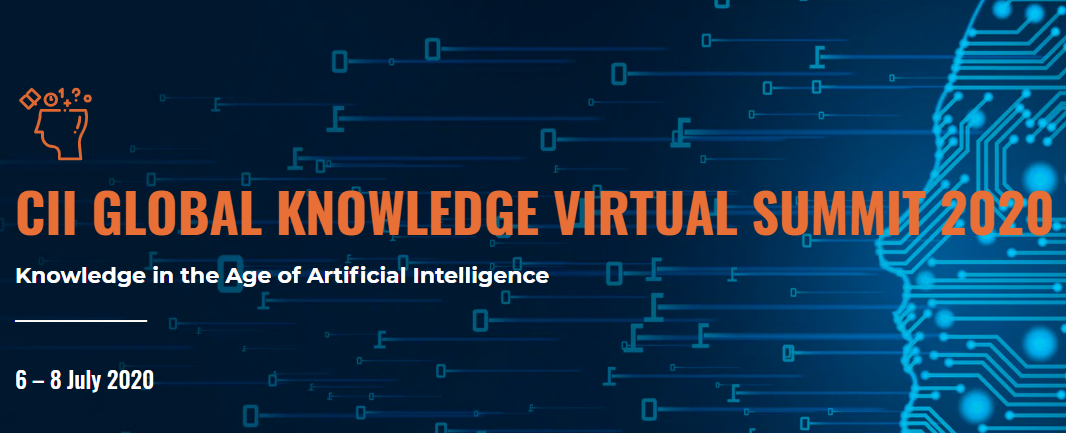CII is hosting a three-day event next month, held online across three afternoons on July 6-8. Titled, CII Global Knowledge Virtual Summit 2020: Knowledge in the Age of Artificial Intelligence, it will feature industry leaders, CKOs/CIOs/CTOs, knowledge analysts, architects, domain experts, business strategists, talent experts, management consultants, and communication managers.

YourStory is the media partner for the Summit this year as well. See Part I, Part II, and Part III of our 2020 coverage, as well as Part I and Part II of our 2019 series. The annual summits promote the harnessing of knowledge via learning cultures, collaborative ecosystems, frameworks like gamification, and leadership commitment.
Gamification in action
Notable impacts of gamification and its impact have been observed in areas like learning, business operations, and marketing explains Zeba Khan, Managing Partner, Xenvis Solutions, in a chat with YourStory. For example, manufacturers leverage technology such as augmented reality (AR) and virtual reality (VR) combined with game elements in training employees on new equipment and procedures.
“This helps prevent errors, accidents, or equipment damage. Using visual gaming elements, businesses can combine classroom and on-the-job training, thereby offering an engaging environment for employees to learn, acquire, and safely practice new skills,” she adds. This allows for quick and effective training, which can also be imparted remotely.
Businesses can use gamification to increase the operational productivity of their employees. “By combining AR, AI, and game elements, employees can be visually guided while performing routine and repetitive tasks,” Zeba says.
Employee performance can be tracked to obtain feedback, and they can be rewarded for their achievements. “Displaying the performance over a fixed period helps employees focus on improvements and stay motivated,” she observes.
“As for marketing, gamification of fitness by sports brands has helped achieve increased customer engagement and brand awareness,” she explains. Fitness apps of brands have enabled users to track their fitness activity, earn badges, connect, and compete with friends, while performing routine exercises or playing sports. “This extends the customer experience beyond the product, and also helps to collect relevant customer data,” she adds.

Rajib Chowdhury, Founder of The Gamification Company (TGC), shared several gamification examples from L&T, French Postal Service, Marriott Hotel, and Google. They span across recruitment, employee performance, and broader social engagement.
Formaposte, the French postal service, used gamification to address employee retention and reduce churn. It launched the Jeu Facteur Academy, where potential candidates could live the life of a postal delivery employee for a week.
“This helped the recruitment process, and the dropout rate fell from 25 percent to eight percent. The game became a permanent part of the recruitment process,” according to Rajib.
He pointed to another successful recruitment-based game called ‘My Marriott Hotel,’ which runs on the hotel chain’s Facebook career page. “Players get a virtual experience of running a hotel, and are redirected to a job application when they click the Do it for real button,” he says.
Rajib also cites Google’s famous billboard mathematical riddle as a sensational example of how useful gamification can be in recruiting. “In 2004, Google invited people to solve a series of equations thinking – correctly – that those who had the brains and the motivation to reach the end would make great candidates,” he explains.
At L&T, a gamification initiative helped drive employee engagement and performance even in a traditional sector like engineering and construction. L&T began its digital transformation journey in 2016, and gamification was used for behaviour transformation, Rajib explains.
His company is developing a gamification initiative to help school students understand and implement the concepts of urban waste management. “Using an innovative ‘Wisdom of the Crowd’ model, the game is designed to engage the broader influencer ecosystem such as parents, teachers, and communities, so that the behaviour transformations are encouraged and sustained,” Rajib explains.
Myths and misconceptions
Despite gamification models have been around for a while, several myths and misconceptions get in the way. Sudip Mazumder, Head of Engineering and Construction, Digital at L&T NxT, and General Manager, L&T Group, points out some of these myths — only ‘sophisticated’ industries like banking or retail can do gamification, and people have to know about it in depth before they take part in it.
“One of the most common misconceptions is that gamification is the same as gaming, and therefore, businesses may feel that it can only be used for amusement or entertainment. This, however, is not true,” Zeba Khan of Xenvis Solutions emphasises.
“Gamification is simply the adoption of game elements in a non-gaming scenario to enhance engagement, motivation, and participation,” she adds. Game elements include interactive visual content, achievement badges, progress tracking, and performance graphs. They can help individuals improve their knowledge and skills.
Rajib Chowdhury of TGC observes that many companies think gamification is only about points, badges, leaderboards, and rewards. “This is far from the truth and is extremely shortsighted – these are only a part of game mechanics and not gamification in itself,” he explains.
Sometimes, gamification is mistakenly used as a replacement for performance management. “But, we must understand that performance management and gamification have two distinct purposes. Performance management is an organisation process, and is designed to differentiate the performers from the non-performers,” he clarifies.
“Gamification, on the other hand, is a human process that is designed to optimise the individual’s capability and subsequently amplify organisational performance,” Rajib emphasises.
Another mistake he observes is the introduction of unrelated games in the business process to distract the mind from the rigour of daily work and try to build motivation. “The purpose of gamification is to build engagement and not create a distraction. Hence, gamification strategies must clearly align to the desired outcomes to bring about sustained behavioural transformations,” he cautions.
Some managers erroneously believe that by launching gamification strategies, engagement will automatically happen. “This is not true. Like any other change process, any gamification strategy needs to be accompanied by a very strong communication strategy spread across pre, post, and closure stages,” Rajib advises.

The scope of gamification
Though gamification can yield benefits, it has to be applied in the proper contexts, the speakers caution. The focus should be on key business objectives and varying formats, along with game mechanics and rewards.
“Gamification scenarios that have little or no relevance to the job and take the focus away from business objectives can result in a negative outcome,” warns Zeba Khan. The key is to design a gamified experience that will motivate employees to achieve their goals or impact customer behaviour in order to meet business objectives.
Sudip Mazumder of L&T NxT cautions against gamification used for too long in the same format, or too frequently. He advises flexibility in adding in-flight features of a gamification intervention.
“Gamification should be used as a booster, else predictability will set in,” he adds. “Gamification is universal. The ‘game’ we play needs to be contextual and appropriate for the occasion, irrespective of the age of the workforce,” Sudip says.
“Lack of a culture of engagement can lead to increasing attrition, falling productivity, and talent drain. Merely giving rewards in a top-down manner is counterproductive. The need is to build engagement bottom-up, and that is where gamification comes in,” Rajib Chowdhury of TGC explains.
“Gamification refuels dried-up motivation, takes the disengaged brain to the highest levels of engagement by taking it into the state of play, and thus, brings about transformation at a belief level. It is a human-focussed design,” he emphasises.
“Gamification principles transcend all age groups and generations,” he observes. He also cites Mckinsey’s research which labels the GenNext as ‘dialoguers’ who are not subservient and have very strong opinions of their own.
“They like to engage in dialogues based on their opinions so that they can buy into the tasks at a belief level. This is where the behavioural sciences and gamification principles come into play. The conventional approach of rewards and consequences is lost on this generation and future ones,” he explains.
“For long-term gamification applications, it is important to keep the strategy alive and fresh through multiple game mechanics, following successive ‘Sine Curves.’ Blended approaches of game-led and other learning mediums are effective,” Rajib observes.
Gamification can cause transformation at belief levels and influence behaviours. “If not managed in a balanced manner, it can give rise to negative behaviours that can become irreversible. Carefully choosing the right gamification approach, game mechanics and rewards strategy is paramount in any successful gamification strategy,” he advises.
Trends in gamification
As workforces become increasingly multi-generational, interesting trends appear with respect to gamification. The rise of innovative technologies and formats will broaden the acceptance of gamification as well.
“The propensity for gamification does not significantly change across generations. However, the ability to adapt to new technology may vary,” observes Zeba Khan. She foresees synergy between AI technology and the roles of the GenNext workforce.
“Gamification will most likely blend with other technologies to deliver effective and sustainable solutions to businesses. Personalised and interactive gamified systems will be the key to obtaining positive results, especially in training and skilling,” she adds.
“Every function will have their own way to boost performance, and workplace entertainment by the way of gamification,” observes Sudip Mazumder. “Gamification needs to be more ‘visible,’ and possibly, have a ‘feel’ factor also. It will be more challenging to gamify processes without technology,” he adds.
The road ahead
The speakers also offer advice for business leaders on how to apply gamification with a positive impact. “Gamification is a technology tool. It is important for business leaders to focus on the larger objectives and challenges they face, and evaluate which technology can help,” advises Zeba Khan of Xenvis Solutions.
A mix of different digital technologies could most likely be the answer. “It is important to highlight the role of visualisation in gamification,” she adds, citing the old adage, A picture is worth a thousand words. “Visualisation with modern tech is probably worth millions more,” she signs off.
“Gamification is a transformation tool for behaviour and culture and is a serious business. It is imperative that there needs to be a well-defined tangible outcome that it needs to deliver. This needs commitment in terms of time, resources, and money,” advises Rajib Chowdhury of TGC.
“It is important to use behavioural sciences and neuroscience of play-led gamification strategies to tap the power of human emotion. By amplifying both individual and organisation outcomes, gamification will be a critical lever that organisations will have to rely on in the times to come,” Rajib predicts.
“All successful gamification strategies start from the top, and need strong buy-in and participation from the leadership,” he emphasies. At a broader level, gamification can also apply at societal and national levels for sustained behavioural transformation, he adds.
“Back gamification. Give rewards of various kinds. Create positive noise around it. Ensure the objectives are met apart from de-stressing people,” advises Sudip Mazumder of L&T NxT. “Make people visible. Create leadership through it. Tomorrow’s leadership will need to be 360-degree personalities,” he emphasises.
He also connects gamification to the CII Summit’s core focus on knowledge management. “KM is not only about documents, skills, training, or even copybooks. Knowledge is created every moment. One can acquire knowledge and pass on anything through their daily experience,” he explains.
“Gamification helps make the knowledge acquisition and sharing process easier and entertaining,” Sudip sums up.
(Edited by Suman Singh)
Want to make your startup journey smooth? YS Education brings a comprehensive Funding Course, where you also get a chance to pitch your business plan to top investors. Click here to know more.
Link : https://yourstory.com/2020/06/gamification-engagement-cii-knowledge-summit
Author :- Madanmohan Rao ( )
June 26, 2020 at 08:00AM
YourStory



